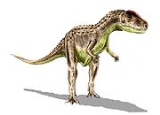
Rugops
Encyclopedia
Rugops is a genus
of theropod dinosaur
which inhabited what is now Africa
approximately 95 million years ago (Cenomanian
stage of the Late Cretaceous
). The discovery of a Rugops skull
in Niger
in 2000 was a crucial breakthrough in the understanding of the evolution of theropods in that area, and demonstrates that this landmass was still united with Gondwana
at that stage in history.
Though known only from a skull, Rugops has been estimated to have been about 6 metres (19.7 ft) long based on comparisons with its relatives. The skull bore armour
or scales, and other bones had many blood vessel
s, causing Dr. Paul Sereno
, who led the team that discovered the fossil, to say, "It's not the kind of head designed for fighting or bone-crushing", suggesting that it may have been a scavenger. The skull also bears two rows of seven holes each, of unknown purpose, although Sereno has speculated that they may have anchored some kind of crest or horns.
Like other abelisaurs, Rugops probably had very short arms. These were probably useless in fighting. They may have only been balance tools, items to counterbalance the dinosaur's head.
The type species
is R. primus (meaning "first wrinkle-face"). Rugops is believed to be an abelisaurid, and is related to Majungasaurus
.
Genus
In biology, a genus is a low-level taxonomic rank used in the biological classification of living and fossil organisms, which is an example of definition by genus and differentia...
of theropod dinosaur
Dinosaur
Dinosaurs are a diverse group of animals of the clade and superorder Dinosauria. They were the dominant terrestrial vertebrates for over 160 million years, from the late Triassic period until the end of the Cretaceous , when the Cretaceous–Paleogene extinction event led to the extinction of...
which inhabited what is now Africa
Africa
Africa is the world's second largest and second most populous continent, after Asia. At about 30.2 million km² including adjacent islands, it covers 6% of the Earth's total surface area and 20.4% of the total land area...
approximately 95 million years ago (Cenomanian
Cenomanian
The Cenomanian is, in the ICS' geological timescale the oldest or earliest age of the Late Cretaceous epoch or the lowest stage of the Upper Cretaceous series. An age is a unit of geochronology: it is a unit of time; the stage is a unit in the stratigraphic column deposited during the corresponding...
stage of the Late Cretaceous
Late Cretaceous
The Late Cretaceous is the younger of two epochs into which the Cretaceous period is divided in the geologic timescale. Rock strata from this epoch form the Upper Cretaceous series...
). The discovery of a Rugops skull
Skull
The skull is a bony structure in the head of many animals that supports the structures of the face and forms a cavity for the brain.The skull is composed of two parts: the cranium and the mandible. A skull without a mandible is only a cranium. Animals that have skulls are called craniates...
in Niger
Niger
Niger , officially named the Republic of Niger, is a landlocked country in Western Africa, named after the Niger River. It borders Nigeria and Benin to the south, Burkina Faso and Mali to the west, Algeria and Libya to the north and Chad to the east...
in 2000 was a crucial breakthrough in the understanding of the evolution of theropods in that area, and demonstrates that this landmass was still united with Gondwana
Gondwana
In paleogeography, Gondwana , originally Gondwanaland, was the southernmost of two supercontinents that later became parts of the Pangaea supercontinent. It existed from approximately 510 to 180 million years ago . Gondwana is believed to have sutured between ca. 570 and 510 Mya,...
at that stage in history.
Though known only from a skull, Rugops has been estimated to have been about 6 metres (19.7 ft) long based on comparisons with its relatives. The skull bore armour
Armour (zoology)
Armour in animals is external or superficial protection against attack by predators, formed as part of the body , usually through the hardening of body tissues, outgrowths or secretions. It has therefore mostly developed in 'prey' species...
or scales, and other bones had many blood vessel
Blood vessel
The blood vessels are the part of the circulatory system that transports blood throughout the body. There are three major types of blood vessels: the arteries, which carry the blood away from the heart; the capillaries, which enable the actual exchange of water and chemicals between the blood and...
s, causing Dr. Paul Sereno
Paul Sereno
Paul Callistus Sereno is an American paleontologist from the University of Chicago who discovered several new dinosaur species on several continents. He has conducted excavations at sites as varied as Inner Mongolia, Argentina, Morocco, and Niger...
, who led the team that discovered the fossil, to say, "It's not the kind of head designed for fighting or bone-crushing", suggesting that it may have been a scavenger. The skull also bears two rows of seven holes each, of unknown purpose, although Sereno has speculated that they may have anchored some kind of crest or horns.
Like other abelisaurs, Rugops probably had very short arms. These were probably useless in fighting. They may have only been balance tools, items to counterbalance the dinosaur's head.
The type species
Type species
In biological nomenclature, a type species is both a concept and a practical system which is used in the classification and nomenclature of animals and plants. The value of a "type species" lies in the fact that it makes clear what is meant by a particular genus name. A type species is the species...
is R. primus (meaning "first wrinkle-face"). Rugops is believed to be an abelisaurid, and is related to Majungasaurus
Majungasaurus
Majungasaurus is a genus of abelisaurid theropod dinosaur that lived in Madagascar from 70 to 65.5 million years ago, at the end of the Cretaceous Period. Only one species has been identified...
.

